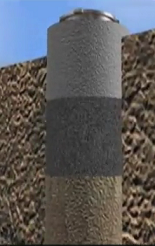 It is imperative that any wastewater treatment plant with facilities to process raw wastewater and sludge handling involving landfills with generation of leachate, aeration ponds and compost systems with potential or possible seepage and transferring of toxic materials to underground water source that may pose significant risk towards reduction of the groundwater quality should have monitoring wells equipment installed. This is important because in the event that degradation of groundwater quality is tested, early remedial steps can be immediately taken to address the problem. Landfills especially must be constantly monitored and samples taken for periodic checks so that corrective and preventative actions can be implemented.
It is imperative that any wastewater treatment plant with facilities to process raw wastewater and sludge handling involving landfills with generation of leachate, aeration ponds and compost systems with potential or possible seepage and transferring of toxic materials to underground water source that may pose significant risk towards reduction of the groundwater quality should have monitoring wells equipment installed. This is important because in the event that degradation of groundwater quality is tested, early remedial steps can be immediately taken to address the problem. Landfills especially must be constantly monitored and samples taken for periodic checks so that corrective and preventative actions can be implemented.Monitoring wells are man-made boreholes completed using different drilling methods and the whole well is either constructed from stainless steel casing or screens with options on using Teflon or either PVC depending on approval from relevant authorities and governmental agencies controlling the wastewater and environmental standards. The depth of individual monitoring wells can vary depending on locations and usually boreholes are drilled until groundwater is found and then further extend another 10 to 15 feet below the water table.
There are certain guidelines pertaining to the drilling method mainly on the part whereby equipment and tools used for the drilling should be properly cleaned and sanitized so that it will not cause problems towards contamination of groundwater. Placement of the boreholes should at least have one located at the up gradient of the treatment facility and another at the sloped downstream. This will allow accurate representation of the samples taken because one will represent the actual blank sample and another is the one possibly contaminated with effluent discharge or wastewater leachate.
Collection of samples from the groundwater requires a certain protocols to be followed. Prior to obtaining the samples, groundwater must be pumped out to produce representative formation water that is when the pH, conductivity readings and temperature are already stable while the appearance of the sample is clear and not cloudy. There is no specific time period as to how long or how much groundwater has to be pumped out but generally the condition mentioned earlier applies. There are various methods to achieve this and sampling wells are usually equipped with groundwater monitoring equipment such as submersible pumps, diaphragm pumps complete with compressed air supply or bailers.
Certain advanced monitoring sites are even equipped with flowmeter to get the amount of water transferred out. Obtained samples are usually tested for pH, ammonia concentration, total dissolved solids but further additional tests such as heavy metals or other toxic compounds may be required depending on what the wastewater treatment plant is built to handle and the final effluent quality. Nowadays to make things easier, there are even monitoring well kits that are already pre-assembled ready to fit and installed for groundwater samples collection.


